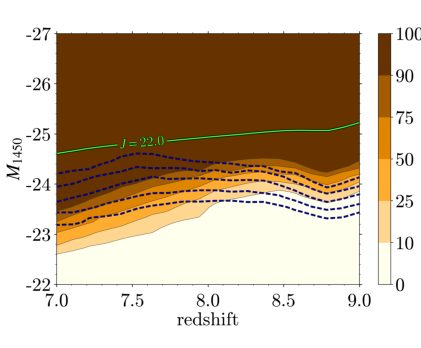Euclid preparation: V. Predicted yield of redshift 7
| Authors: | Euclid Collaboration, R. Barnett, ..., S. Farrens, M. Kilbinger, V. Pettorino, F. Sureau, et al. |
| Journal: | Astronomy and Astrophysics |
| Year: | 2019 |
| DOI: | 10.1051/0004-6361/201936427 |
| Download: |
Abstract
We provide predictions of the yield of 7<z<9 quasars from the Euclid wide survey, updating the calculation presented in the Euclid Red Book in several ways. We account for revisions to the Euclid near-infrared filter wavelengths; we adopt steeper rates of decline of the quasar luminosity function (QLF; Φ) with redshift, Φ∝10k(z−6), k=−0.72, and a further steeper rate of decline, k=−0.92; we use better models of the contaminating populations (MLT dwarfs and compact early-type galaxies); and we use an improved Bayesian selection method, compared to the colour cuts used for the Red Book calculation, allowing the identification of fainter quasars, down to JAB∼23. Quasars at z>8 may be selected from Euclid OYJH photometry alone, but selection over the redshift interval 7<z<8 is greatly improved by the addition of z-band data from, e.g., Pan-STARRS and LSST. We calculate predicted quasar yields for the assumed values of the rate of decline of the QLF beyond z=6. For the case that the decline of the QLF accelerates beyond z=6, with k=−0.92, Euclid should nevertheless find over 100 quasars with 7.0<z<7.5, and ∼25 quasars beyond the current record of z=7.5, including ∼8 beyond z=8.0. The first Euclid quasars at z>7.5 should be found in the DR1 data release, expected in 2024. It will be possible to determine the bright-end slope of the QLF, 7<z<8, M1450<−25, using 8m class telescopes to confirm candidates, but follow-up with JWST or E-ELT will be required to measure the faint-end slope. Contamination of the candidate lists is predicted to be modest even at JAB∼23. The precision with which k can be determined over 7<z<8 depends on the value of k, but assuming k=−0.72 it can be measured to a 1 sigma uncertainty of 0.07.

